Effect of Mg Treatment on Refining the Microstructure and Improving the Toughness of the Heat-Affected Zone in Shipbuilding Steel
Abstract
:1. Introduction
2. Experimental Section
2.1. Laboratory Experiments
2.2. Industrial Experiments
2.3. Laboratory Detection
3. Results and Discussion
3.1. Effect of the Microalloy Element Mo on the Microstructure
3.2. Effect of Microalloy Elements V and Nb on the Microstructure
3.3. Effect of the Microalloy Mg Addition Sequence on the Microstructure
3.3.1. Inclusions Size in Different Microalloy Addition Sequence
3.3.2. Chemical Compositions of Inclusions in Different Microalloy Addition Sequence
3.3.3. Microstructures in Different Microalloy Addtion Sequences
3.4. Industrial Testing
4. Conclusions
Author Contributions
Funding
Acknowledgments
Conflicts of Interest
References
- Takamura, J.I.; Mizoguchi, S. Role of Oxides in Steels Performance, Metallurgy of Oxides in Steels. In Proceedings of the 6th International Iron and Steel Congress, Nagoya, Japan, 21–26 October 1990; pp. 591–597. [Google Scholar]
- Johason, M.Q.; Evans, G.M.; Edwards, G.R. The Influence of Titanium Additions and Interpass Temperature on the Microstructures and Mechanical Properties of High Strength SMA Weld Metals. ISIJ Int. 1995, 35, 1222–1231. [Google Scholar] [CrossRef]
- Lee, J.L.; Pan, Y.T. Effect of sulfur content on the microstructure and toughness of simulated Heat-Affected zone in Ti-Killed steels. Metall. Mater. Trans. A 1993, 24, 1399–1408. [Google Scholar] [CrossRef]
- Wang, C.; Misra, R.D.K.; Shi, M.H.; Zhang, P.Y.; Wang, Z.D.; Zhu, F.X.; Wang, G.D. Transformation behavior of a Ti–Zr deoxidized steel: Microstructure and toughness of simulated coarse grain heat affected zone. Mater. Sci. Eng. A 2014, 594, 218–228. [Google Scholar] [CrossRef]
- Jiang, G.C.; Zhu, Y.R.; Guo, S.Q.; Xu, J.L.; Wang, Y.Q.; Pan, L.Y.; Yu, D.W. The existence of intragranular ferrite plates and nucleating inclusions in the heat affected zone of X-60 pipe steel. J. Mater. Sci. 1997, 32, 2985–2989. [Google Scholar] [CrossRef]
- Kang, Y.J.; Jang, J.H.; Park, J.H. Influence of Ti on Non-Metallic Inclusion Formation and Acicular Ferrite Nucleation in High-Strength Low-Alloy Steel Weld Metals. Met. Mater. Int. 2014, 20, 119–127. [Google Scholar] [CrossRef]
- Zhang, D.; Terasaki, H.; Komizo, Y.I. In situ observation of the formation of intragranular acicular ferrite at non-metallic inclusions in C-Mn steel. Acta Mater. 2010, 58, 1369–1378. [Google Scholar] [CrossRef]
- Kang, Y.J.; Jang, J.H.; Park, J.H.; Lee, C.H. Mn-Depleted Zone Formation in Rapidly Cooled High-Strength Low-Alloy Steel Welds. Metall. Mater. Trans. A 2014, 45, 4753–4757. [Google Scholar] [CrossRef]
- Koseki, T. A Review on Inclusion-assisted Microstructure Control in C-Mn and Low-alloy Steel Welds. Weld. World 2005, 49, 22–28. [Google Scholar] [CrossRef]
- Zhang, S.; Hattori, N.; Enomoto, M.; Tarui, T. Ferrite nucleation at ceramic/austenite interfaces. ISIJ Int. 1996, 36, 1301–1309. [Google Scholar] [CrossRef]
- Byun, J.S.; Shim, J.H.; Cho, Y.W.; Lee, D.N. Non-metallic inclusion and intragranular nucleation of ferrite in Ti-killed C-Mn steel. Acta Mater. 2003, 51, 1593–1606. [Google Scholar] [CrossRef]
- Madariaga, I.; Gutiérrez, I. Role of the particle–matrix interface on the nucleation of acicular ferrite in a medium carbon microalloyed steel. Acta Mater. 1999, 47, 951–960. [Google Scholar] [CrossRef]
- Suito, H.; Karasev, A.V.; Hamada, M.; Inoue, R.; Nakajima, K. Influence of Oxide Particles and Residual Elements on Microstructure and Toughness in the Heat-Affected Zone of Low-Carbon Steel Deoxidized with Ti and Zr. ISIJ Int. 2011, 51, 1151–1162. [Google Scholar] [CrossRef] [Green Version]
- Li, Y.; Crowther, D.N.; Green, M.J.W.; Mitchell, P.S.; Baker, T.N. The effect of vanadium and niobium on the properties and microstructure of the intercritically reheated coarse grained heat affected zone in low carbon microalloyed steels. ISIJ Int. 2001, 41, 46–55. [Google Scholar] [CrossRef]
- Bramfitt, B.L. The effect of carbide and nitride additions on the heterogeneous nucleation behavior of liquid iron. Metall. Mater. Trans. B 1970, 7, 1987–1995. [Google Scholar] [CrossRef]
- Shim, J.H.; Cho, Y.W.; Chung, S.H.; Shim, J.D.; Lee, D.N. Nucleation of Intragranular Ferrite at Ti2O3 Particle in Low Carbon Steel. Acta Mater. 1999, 47, 2751–2760. [Google Scholar] [CrossRef]
- Lee, J.L.; Pan, Y.T. Effect of killing time on the microstructure and toughness of the heat-affected zone in Ti-killed steels. Metall. Mater. Trans. A 1991, 22, 2818–2822. [Google Scholar] [CrossRef]
- Jin, H.H.; Shim, J.H.; Cho, Y.W.; Lee, H.C. Formation of Intragranular Acicular Ferrite Grains in a Ti-containing Low Carbon Steel. ISIJ Int. 2003, 43, 1111–1113. [Google Scholar] [CrossRef] [Green Version]
- Ohta, H.; Suito, H. Effects of N, C and Si Contents and MgO on Dispersion of TiN Particles in Fe-1.5%Mn-0.05(0.15) %C Alloy. ISIJ Int. 2007, 47, 197–206. [Google Scholar] [CrossRef]
- Kim, S.K.; Suito, H.; Inoue, R. Effect of Multi-phase Oxide Particles on TiN Crystallization and Solidification Structure in Ti-Added Ferritic Stainless Steel. ISIJ Int. 2012, 52, 1935–1944. [Google Scholar] [CrossRef] [Green Version]
- Wen, B.; Song, B.; Pan, N.; Mao, J.H. Effect of SiMg alloy on inclusions and microstructures of 16Mn steel. Ironmak. Steelmak. 2011, 38, 577–583. [Google Scholar] [CrossRef]
- Xu, L.Y.; Yang, J.; Wang, R.Z.; Wang, Y.N.; Wang, W.L. Effect of Mg Content on the Microstructure and Toughness of Heat-Affected Zone of Steel Plate after High Heat Input Welding. Metall. Mater. Trans. A 2016, 47, 3354–3364. [Google Scholar] [CrossRef]
- Park, J.S.; Park, J.H. Effect of Mg-Ti Deoxidation on the Formation Behavior of Equiaxed Crystals during Rapid Solidification of Iron Alloys. Steel Res. Int. 2014, 85, 1303–1309. [Google Scholar] [CrossRef]
- Yang, J.; Xu, L.Y.; Zhu, K.; Wang, R.Z.; Zhou, L.J.; Wang, W.L. Improvement of HAZ Toughness of Steel Plate for High Heat Input Welding by Inclusion Control with Mg Deoxidation. Steel Res. Int. 2015, 86, 619–625. [Google Scholar] [CrossRef]
- Song, M.M.; Song, B.; Hu, C.L.; Xin, W.B.; Song, G.Y. Formation of Acicular Ferrite in Mg Treated Ti-bearing C-Mn Steel. ISIJ Int. 2015, 55, 1468–1473. [Google Scholar] [CrossRef]
- Li, X.B.; Zhang, T.S.; Yin, M.; Liu, C.J.; Jiang, M.F. Effect of magnesium addition in low-carbon steel part 1: Behaviour of austenite grain growth. Ironmak. Steelmak. 2017. [Google Scholar] [CrossRef]
- Babakhani, A.; Ziaei, S.M.R.; Kiani-Rashid, A.R. Investigation on the effects of hot forging parameters on the austenie grain size of vanadium microalloyed forging steel (30MSV6). J. Alloys Compd. 2010, 490, 572–575. [Google Scholar] [CrossRef]
- Morrison, W.B. Microalloy steels-the beginning. Mater. Sci. Technol. 2009, 25, 1066–1073. [Google Scholar] [CrossRef]
- Turkdogan, E.T. Cause and Effects on Nitride and Carbonitride Precipitation in HSLA Steel in Relation to Continuous Casting. Steelmak. Conf. Proc. 1987, 70, 399–403. [Google Scholar]
- Zhu, L.G.; Wang, Y.; Wang, S.M.; Zhang, Q.J.; Zhang, C.J. Research of microalloy elemens to induce intragranular acicular ferrite in shipbuilding steel. Ironmak. Steelmak. 2017. [Google Scholar] [CrossRef]


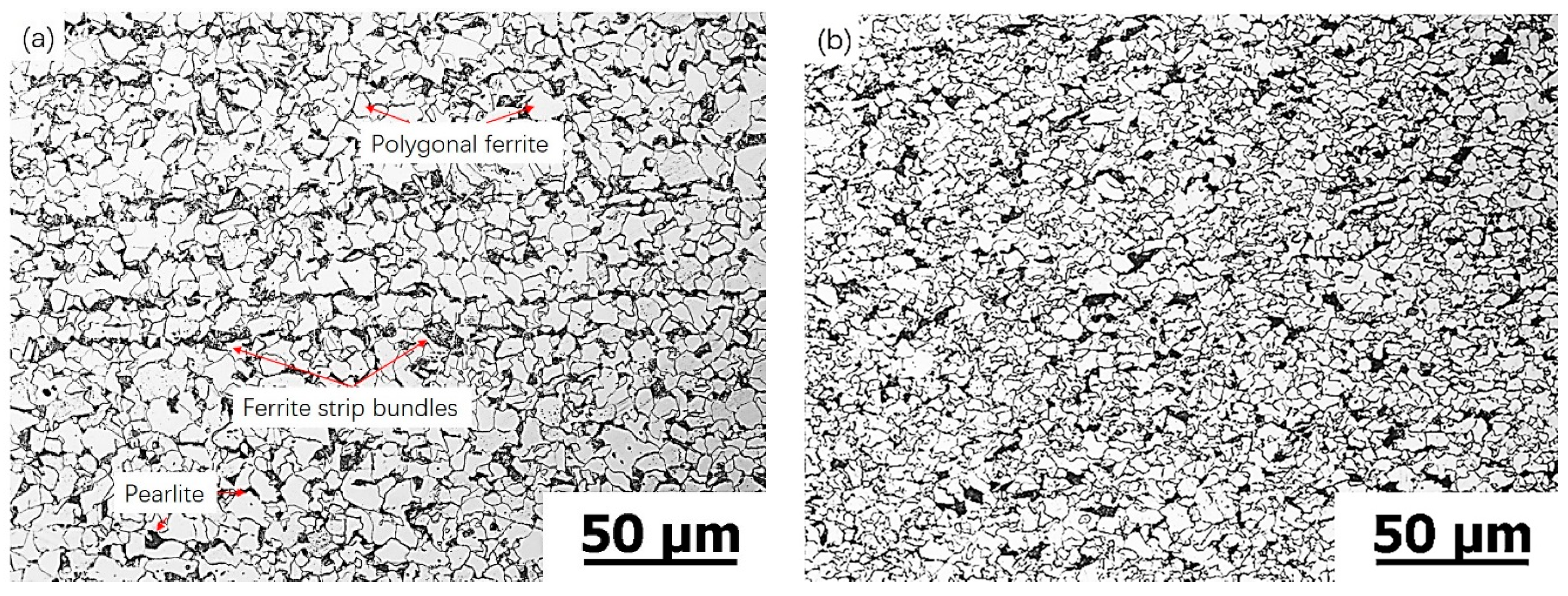
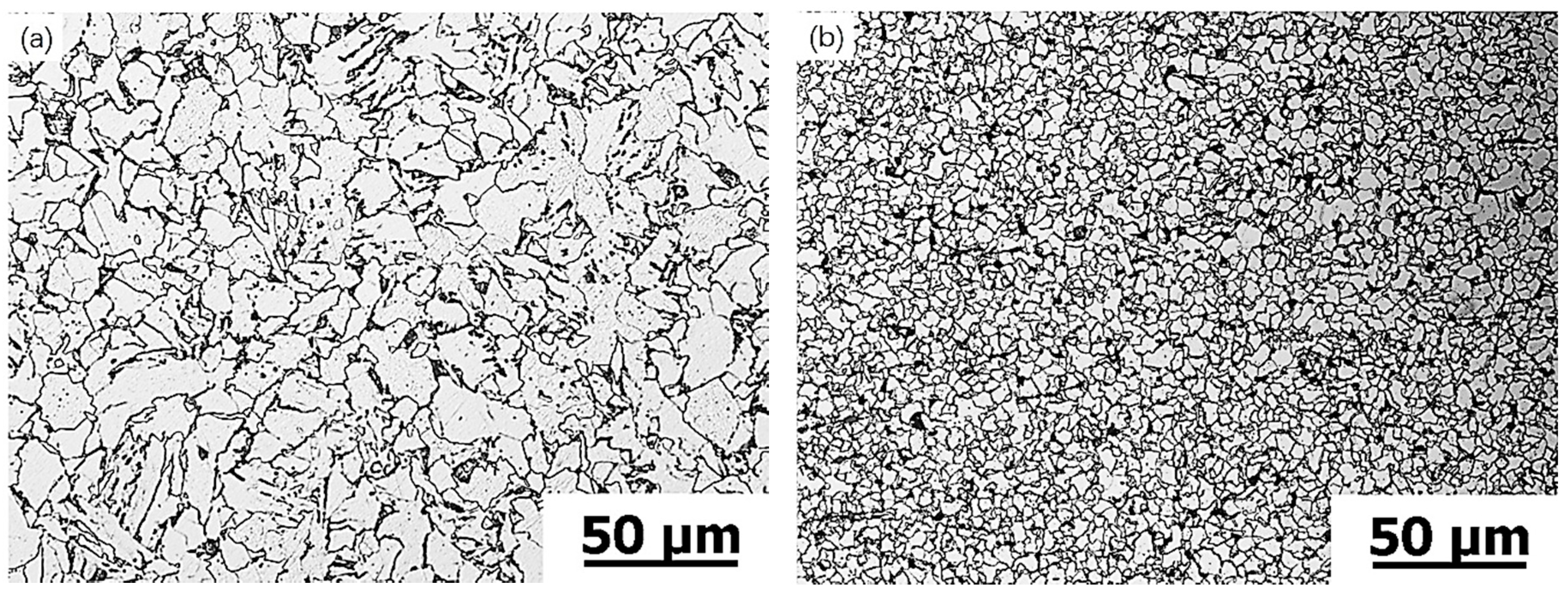

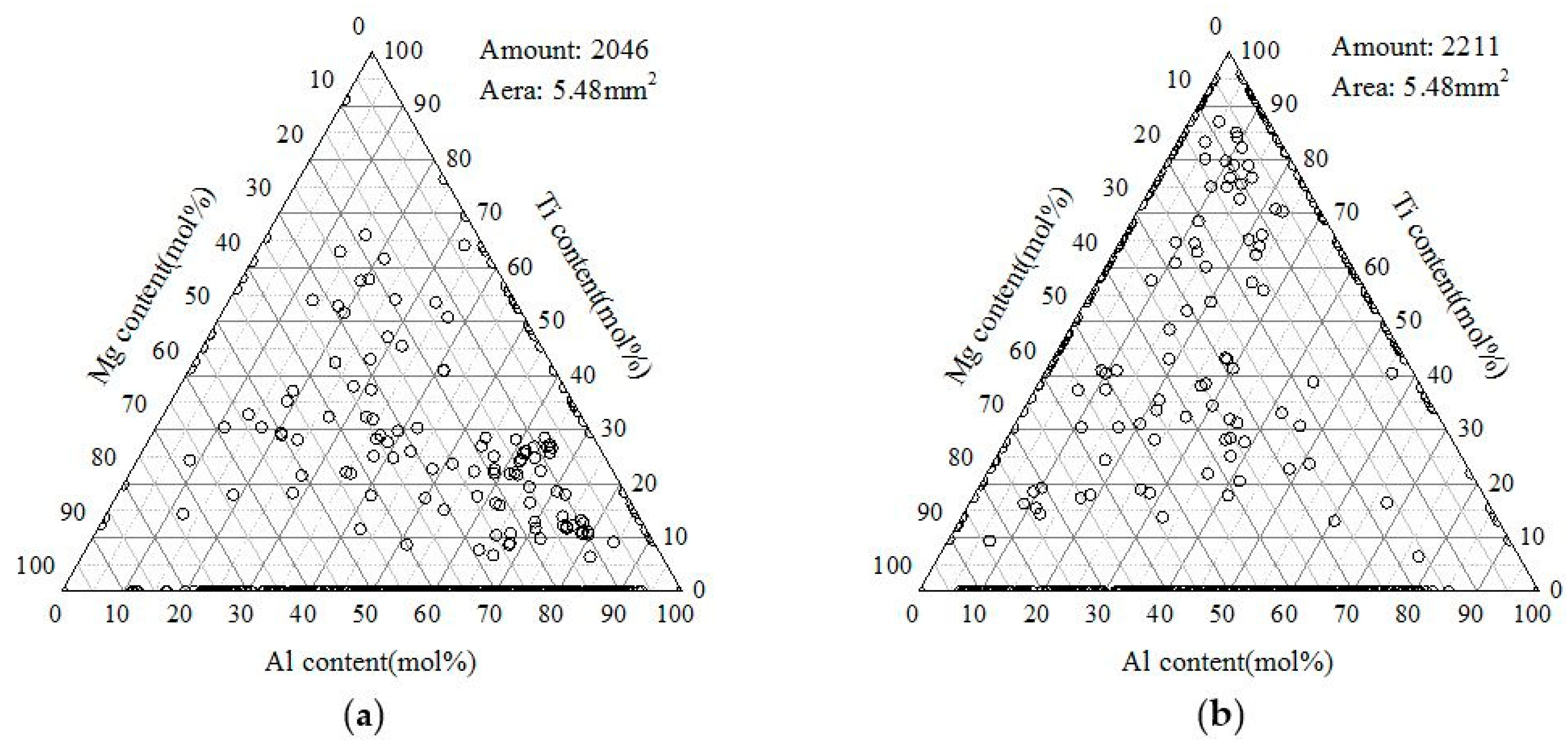


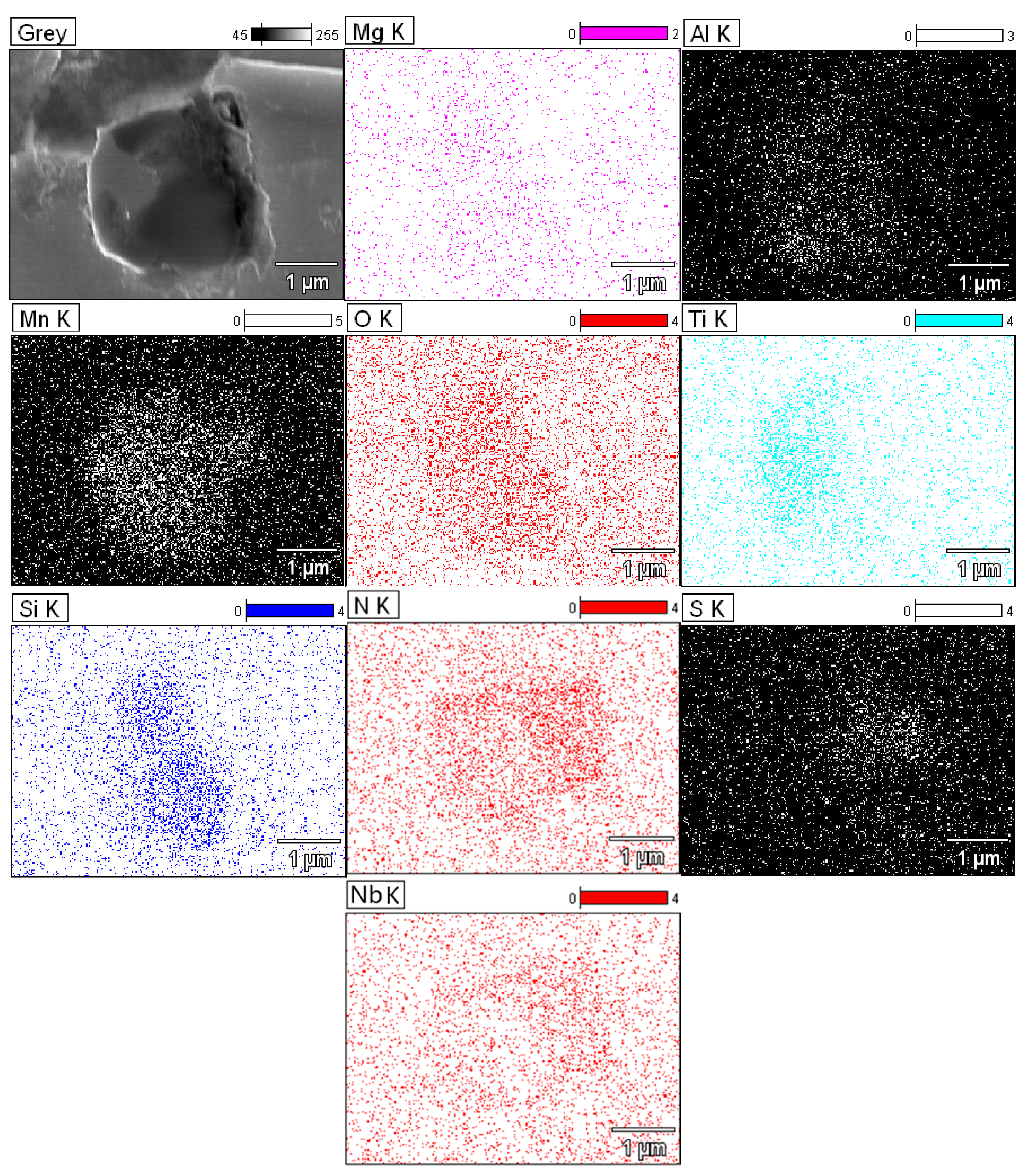

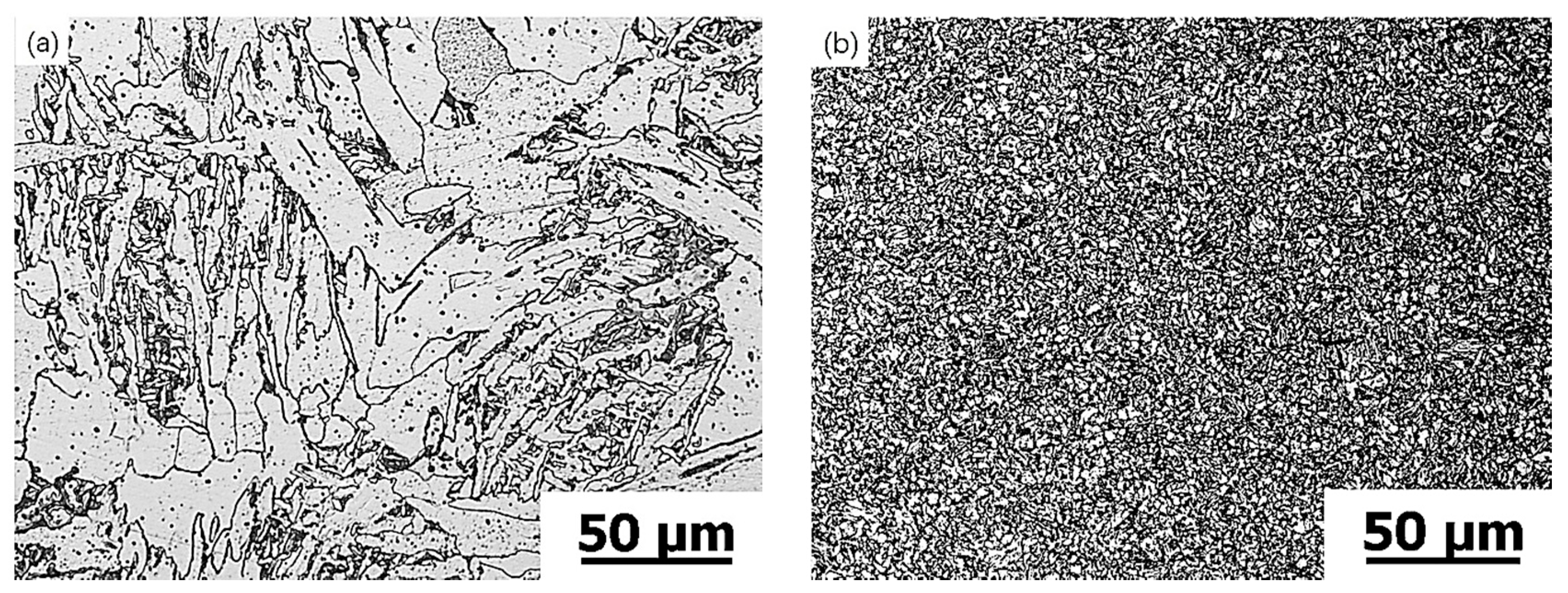



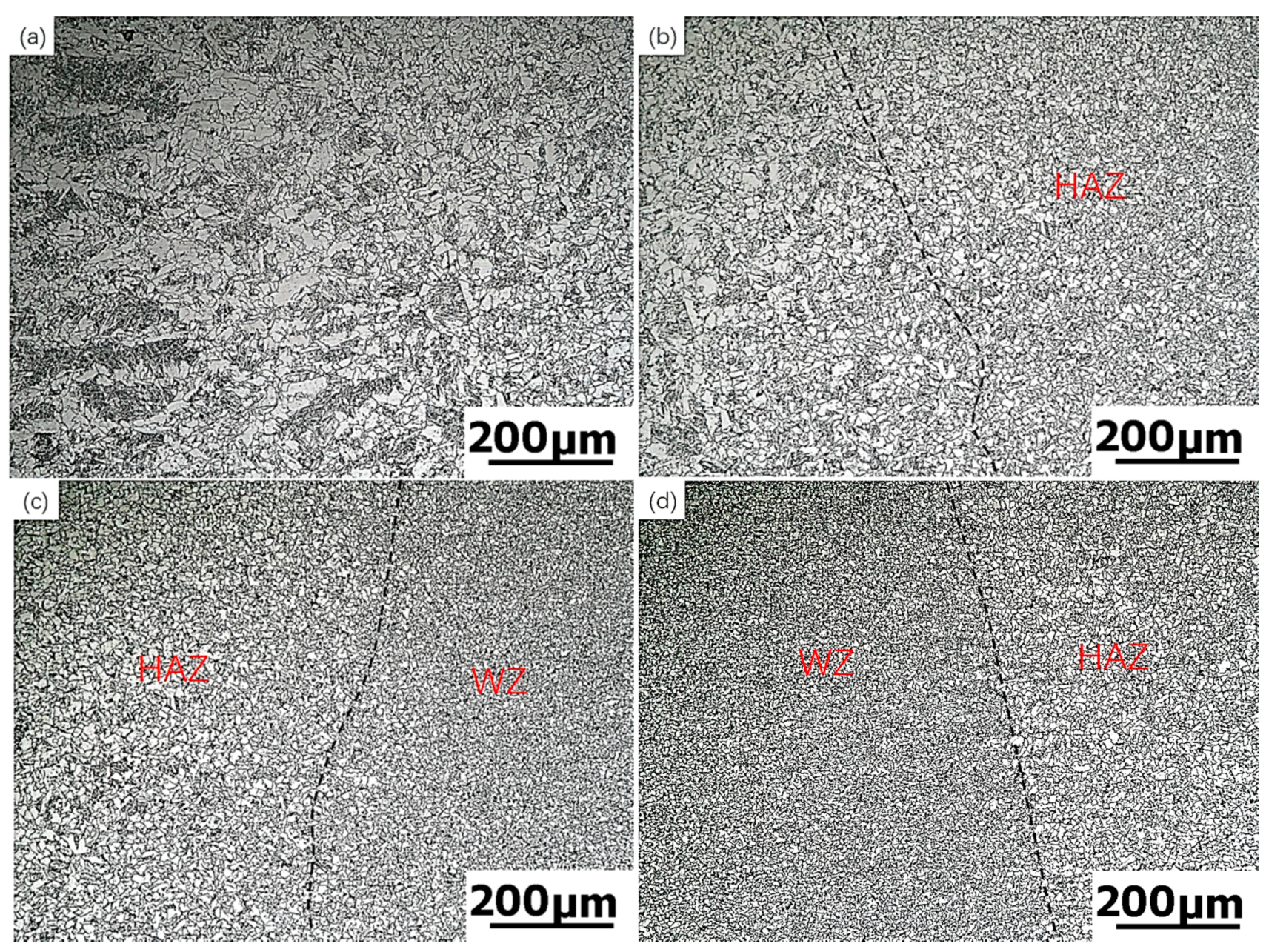


| Composition | C | Mn | S | P | Si | Al | Ti | Mo | Mg | V | Nb | Ca |
|---|---|---|---|---|---|---|---|---|---|---|---|---|
| Steel 1 | 0.07 | 1.43 | 0.004 | 0.016 | 0.19 | 0.01 | 0.019 | - | 0.005 | - | - | - |
| Steel 2 | 0.07 | 1.44 | 0.004 | 0.023 | 0.20 | 0.01 | 0.019 | 0.07 | 0.006 | - | - | |
| Steel 3 | 0.07 | 1.44 | 0.004 | 0.016 | 0.20 | 0.01 | 0.019 | 0.07 | 0.005 | 0.040 | - | - |
| Steel 4 | 0.07 | 1.46 | 0.004 | 0.026 | 0.20 | 0.01 | 0.020 | 0.07 | 0.006 | - | 0.040 | - |
| Steel GY | 0.08 | 1.63 | 0.004 | 0.01 | 0.25 | 0.03 | 0.018 | 0.07 | 0.004 | - | 0.039 | 0.002 |
| Test steel | The Low-Temperature Impact | ||
|---|---|---|---|
| Value (J) | Average (J) | Deviations | |
| Without Mo | 9.8 | 10.3 | 0.455 |
| 10.9 | |||
| 10.2 | |||
| With Mo | 79 | 74 | 12.356 |
| 86 | |||
| 57 | |||
| With V | 19 | 22 | 2.449 |
| 25 | |||
| 22 | |||
| With Nb | 81.2 | 83.6 | 4.877 |
| 90.4 | |||
| 79.2 | |||
| With Al–Ti–Mg | 10.2 | 8.9 | 1.435 |
| 6.9 | |||
| 9.6 | |||
| With Al–Mg–Ti | 74.9 | 75.6 | 3.910 |
| 80.7 | |||
| 71.2 | |||
| Location | The Average Size | ||
|---|---|---|---|
| Value (μm) | Average (μm) | Deviations | |
| HAZ | 6.8 | 7.3 | 0.356 |
| 7.5 | |||
| 7.6 | |||
| Original austenite | 45.06 | 43.07 | 1.408 |
| 42.13 | |||
| 42.02 | |||
© 2018 by the authors. Licensee MDPI, Basel, Switzerland. This article is an open access article distributed under the terms and conditions of the Creative Commons Attribution (CC BY) license (http://creativecommons.org/licenses/by/4.0/).
Share and Cite
Wang, Y.; Zhu, L.; Zhang, Q.; Zhang, C.; Wang, S. Effect of Mg Treatment on Refining the Microstructure and Improving the Toughness of the Heat-Affected Zone in Shipbuilding Steel. Metals 2018, 8, 616. https://doi.org/10.3390/met8080616
Wang Y, Zhu L, Zhang Q, Zhang C, Wang S. Effect of Mg Treatment on Refining the Microstructure and Improving the Toughness of the Heat-Affected Zone in Shipbuilding Steel. Metals. 2018; 8(8):616. https://doi.org/10.3390/met8080616
Chicago/Turabian StyleWang, Yan, Liguang Zhu, Qingjun Zhang, Caijun Zhang, and Shuoming Wang. 2018. "Effect of Mg Treatment on Refining the Microstructure and Improving the Toughness of the Heat-Affected Zone in Shipbuilding Steel" Metals 8, no. 8: 616. https://doi.org/10.3390/met8080616





